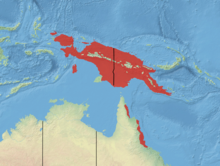Big striped bag
| Big striped bag | ||||||||||||
|---|---|---|---|---|---|---|---|---|---|---|---|---|

Large striped bagger, photo from Crater Lakes National Park |
||||||||||||
| Systematics | ||||||||||||
|
||||||||||||
| Scientific name | ||||||||||||
| Dactylopsila trivirgata | ||||||||||||
| Gray , 1858 |
The large striped bucket ( Dactylopsila trivirgata ) is a species of the glide bucket (Petauridae) that occurs in New Guinea and northeastern Australia.
Occurrence and subspecies
There are four subspecies:
- Dactylopsila trivirgata trivirgata , the nominate form occurs in western New Guinea, on the island of Yapen and on the Aru islands .
- Dactylopsila trivirgata kataui lives in central and southern New Guinea in the catchment area of the Fly .
- Dactylopsila trivirgata melampus occurs in the east of Papua New Guinea .
- Dactylopsila trivirgata picata lives in the rainforests on the northeast coast of the Australian state of Queensland , from the Kutini Payamu National Park to the Paluma Range National Park .
features
The large striped bucket reaches a head-trunk length of 24 to 28 cm, has a 32 to 39 cm long tail and weighs around 430 to 545 g (males) or 310 to 475 g (females). The fur is whitish to light gray. Three dark brown to black stripes run down the back. Compared to the Tate striped bagger ( D. tatei ), the large striped bagger has a longer tail, but it is not as bushy as that of the brush- tailed striped bagger ( D. megalura ). It can be distinguished from the long-fingered striped pouch ( D. palpator ) by the significantly less elongated fourth finger of the forehand.
Habitat and way of life
The great striped bucket lives in lowland rainforests and in the lower areas of the mountain rainforests, in northeast Australia, where the rainforest area is very small, also in adjacent other forest types (e.g. forests with eucalyptus and myrtle heaths ). The animals are nocturnal and spend the day in nests in tree hollows or between large epiphytes . They feed mainly on beetle larvae that drill in rotten wood. When searching for food, they loosen bark and rotten wood with their strong upper incisors and then use their long fourth finger to pull the larva out of its borehole, similar to what the Malagasy finger animals do. They also eat beetles, ants, termites, moths, crickets, cockroaches , Schnabelkerfe , spiders, fruits, plant juices (e.g. from acacias ) and possibly also nectar. Large striped pouches reproduce all year round, in Australia possibly with an accumulation from March to June. One to two young animals are born per litter. Large striped pouches utter two-syllable guttural sounds ("gar-gair, gar-gair"). They are preyed on by amethyst pythons and owls. Captured animals emit loud emergency calls, whereupon other striped hulls approach quickly to hate the predator .
Danger
The IUCN classifies the large striped bagger as Least Concern . The reason is the very large distribution area and the occurrence in different protected areas.
supporting documents
- ↑ a b c d e Stephen Jackson: Family Petauridae (Striped Possums, Leadbeater's Possum and Lesser Gliders). In: Don E. Wilson , Russell A. Mittermeier : Handbook of the Mammals of the World - Volume 5. Monotremes and Marsupials. Lynx Editions, 2015, ISBN 978-84-96553-99-6 , p. 560.
- ↑ Stephen Jackson, Colin Groves: Taxonomy of Australian Mammals. Csiro Publishing, 2015, ISBN 978-1-4863-0013-6 . (Reading sample)
- ↑ a b Dactylopsila trivirgata in the endangered Red List species the IUCN 2016 Posted by: Salas, L. Dickman, C., slipway, K. Burnett, S. & Martin, R., 2015. Accessed June 30 208.
